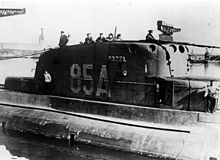Polish armed forces in the west
Origin of the volunteers of
the Polish Armed Forces in the West
| Deserters from the Wehrmacht | 89,300 | (35.8%) |
| Evacuated from the USSR in 1941 | 83,000 | (33.7%) |
| Evacuated from France in 1940 | 35,000 | (14.0%) |
| Liberated prisoners of war | 21,750 | (8.7%) |
| Refugees from occupied countries | 14.210 | (5.7%) |
| Recruited in France | 7,000 | (2.8%) |
| Polonia from Argentina , Brazil and Canada | 2,290 | (0.9%) |
| Polonia from England | 1,780 | (0.7%) |
| Total | 249,000 |
The Polish Armed Forces in the West ( German Polskie Siły Zbrojne na Zachodzie , PSZ ) were the seventh largest army of the anti-Hitler coalition in Europe during World War II after the Soviet, US, British, French, Yugoslav and Canadian armed forces . They consisted of the 1st and 2nd Polish Corps , the Polish Navy and the Polish Air Force .
history
The Polish government in exile of the Second Polish Republic had after the German invasion of Poland based first in France (Paris, later Angers ) and coordinated from there its forces. The first units from exiled Poland were set up in France as early as September 1939. Shortly before France's surrender in June 1940, the seat of the government in exile was relocated to London.
PSZ units were first used in May 1940 at the Battle of Narvik . About 84,000 PSZ soldiers were deployed against the German French campaign in May / June 1940. Shortly before the defeat of France, around 35,000 of them were evacuated to Great Britain and the Mandate Palestine, which is under British administration . Polish fighter pilots were deployed during the Battle of Britain from October 1940. In September 1941, the Polish 1st Paratrooper Brigade was established. The Polish 1st Panzer Division followed in the following year . All of these units formed the 1st Polish Corps on April 28, 1940 . In 1943 the 2nd Polish Corps was formed in Iraq.
Ships of the Polish Navy escorted 787 convoys and were represented in both the Atlantic and the Mediterranean theater of war .
In May 1945 the strength of the PSZ was 210,000 soldiers. In 1947 the PSZ were demobilized.
Main battles

- 1940: Battle of Narvik
- 1940: Western campaign
- from 1940: Battle of Britain
- 1941: Siege of Tobruk
- 1944: Operation Market Garden
- 1944: Battle of Monte Cassino
- 1944: Battle of Caen
- 1944: Falaise cauldron ( Mont Ormel )
- 1944: Breda # Second World War
- 1944: Ancona # story
- 1945: Bologna # history
Interned Polish soldiers in Switzerland
In June 1940, in the western campaign over 12,000 soldiers of the 2nd Infantry Polish Rifle Division under the command of Bronisław Prugar-Kettling cut in France's supply lines and the Swiss border crowded. To avoid capture, the soldiers crossed the border and were interned in Switzerland until the end of the war . There they did work, especially in road construction. The roads built are mostly referred to as Poland Roads or Poland Paths to this day .
See also
- Poland Path # history
- Polish Armed Forces in the Soviet Union
- Polish army before World War II
- Polish zone of occupation
literature
- Jerzy B. Cynk:
- The Polish Air Force at War: The Official History Vol.1 1939–1943 (Schiffer Military History, 2004)
- The Polish Air Force at War: The Official History Vol.2 1943–1945 (Schiffer Military History, 2004)
- Adam Zamoyski: The Forgotten Few: The Polish Air Force in the Second World War . 1995, ISBN 978-0-7818-0421-9 .
- Michael Alfred Peszke: Poland's Navy 1918-1945 , Hippocrene Books Inc., New York 1999, ISBN 0-7818-0672-0 .
- Stanisław M. Piaskowski: Okręty Rzeczypospolitej Polskiej 1920–1946 [The Ships of the Republic of Poland 1920–1946] . Album Planów, Warsaw 1996, ISBN 83-900217-2-2 .
Web links
- ( Page no longer available , search in web archives: official website of the Polish Foreign Ministry on the subject )
Individual evidence
- ↑ CHAPTER ONE: "Our March is towards Poland, Whole, Free and Independent" - The Origins of the Polish Armed Forces Question. . Angelfire.com. Retrieved June 21, 2010.
- ^ Contents, Preface